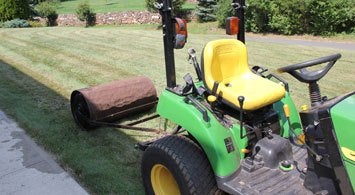
Fall is upon us, and for those with cool season grasses, now is the time to take steps that will lead to a lush lawn next year.
Lawn care isn’t rocket science. You fertilize, water, mow and control weed infestation. After a few years, though, you probably are wondering why the lawn just isn’t as nice as it once was. That’s because the rate of grass reproduction slows after a few years. New seed is required, and the method of accomplishing this for established lawns is known as overseeding.
Grass seed falls in two major categories: warm season grasses and cool season grasses. Warm season grasses grow best in hot weather and are typically found in the South. Warm season grasses go dormant in cool weather and the best time for planting is in late spring. Cool season grasses are best planted in the early spring or late summer/early fall. Spring time seeding adds the complication of having the perfect conditions for the growth of weeds, so most consider the fall the better choice. Fall is also an effective time to fertilize and many experts will say that if you only fertilize once, the fall is the best time to do so.
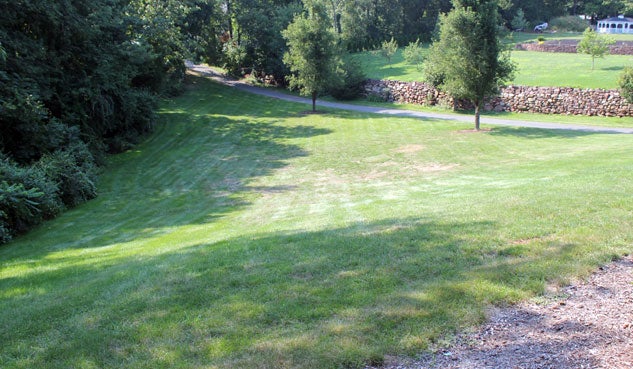
Cool weather grass overseeding is what this article will focus on. But before you start, it’s a good idea to have your soil tested. Additives such as lime may be helpful and can be added at the same time. Soil testing is conducted by government agencies and many universities, often for free or at a minimal charge.
VIEW: How To Shop For A Tractor
So you’ve picked the optimum time of year to overseed, had the soil tested for pH and nutrient needs and now you are are ready to go. What’s next? The basic steps for overseeding aren’t complicated: cut the lawn, pick up clippings, dethatch and/or aerate, apply seed and starter fertilizer, add water. These steps all can be accomplished with minimal tools and effort as long as your yard is small. But if it isn’t, and that will be the focus of this piece, we’ve got some suggestions that will help get the job done and allow you to move on to other things.
Cut the Grass
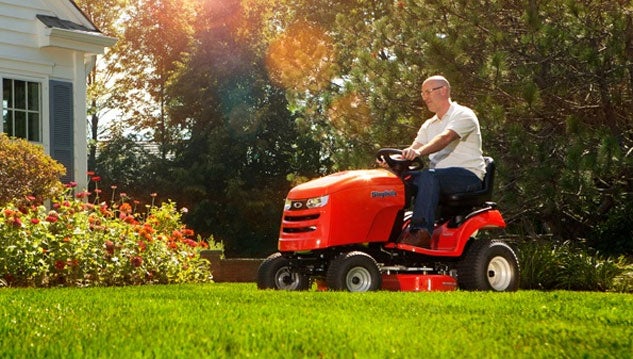
First mow the lawn to a late fall cut height (usually 1” – 1-1/2” depending on the type of grass). This will reduce competition from established grasses and weeds. After mowing, pick up the loose clippings. This will help prevent seed from getting trapped in the loose, tall grass and allow sunlight to reach the germination level of the new seed bed.
Dethatch and/or Aerate
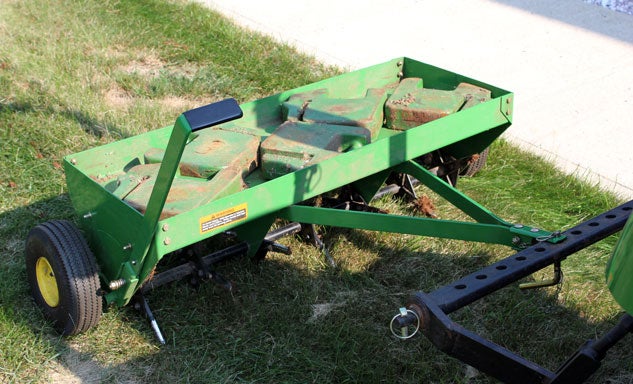
Next dethatch the lawn. Hand rake dethatchers are a simple means of achieving this but for anything other than a very small lawn or for spot dethaching, are too labor intensive. Pull behind tine aerators are available for rent or purchase and are more efficient tools for removing built-up thatch. A core aerator is another tool that can help keep a lawn at its healthiest. Golfers will know courses aerate twice a year, and for good reason. Core aerating promotes stronger roots, improves heat and drought stress tolerance, improves thatch breakdown, reduces puddling, improves air exchange between soil and the atmosphere and reduces compaction. Core aerators, or spoon/plug style aerators, can be rented locally and are almost always gas engine driven. Alternatively, a pull-behind core aerator can be used. Pull-behind aerators can be rented or purchased for as little as $150. Spike aerators cost a little less but are less effective at penetrating and aerating the soil. Pull-behind aerators tend to leave a lesser amount of cores per square foot than engine powered aerators and so it is advisable to aerate the lawn in one direction and then again from another.
Select and Apply Seed
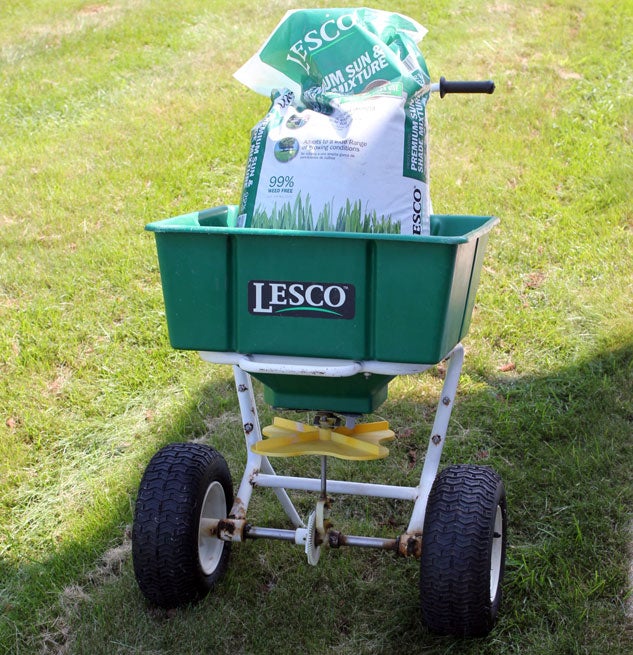
Seed comes in formulations engineered for both sunny and shady conditions and with varying degrees of drought resistance. Best results will be had by picking the correct seed for your climate and conditions. And don’t skimp here. Pick a quality seed with minimal weed content (below 0.5%), minimal filler content (below 2%), and avoid seed containing “variety not stated.” Blends can be helpful for better disease resistance and for a more uniform looking lawn. Germination percentages should be rated above 75% and while you’re at it, pay attention to the expiration date as expired seed may not germinate properly. We prefer applying seed using a broadcast spreader, though other methods can work just as well. Coverage should be per the label suggestion, but keep in mind light seed doesn’t travel as far as heavier fertilizer. Overseeding rates are typically half that of starting a new lawn from scratch.
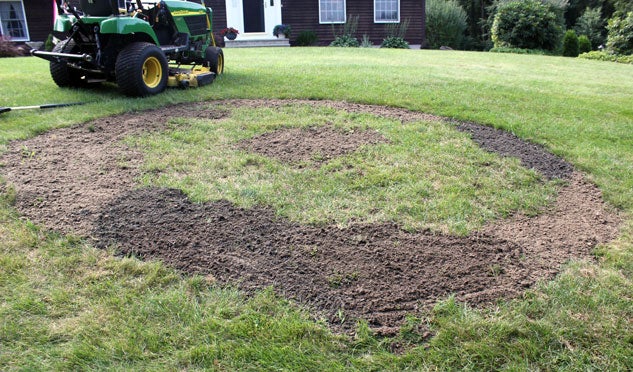
Before you apply seed, take a close look at your lawn. Are there bare spots or areas that have settled? If so, it may be advisable to fill those in with topsoil first.
VIEW: How To Maintain A Compact Utility Tractor
Fertilize
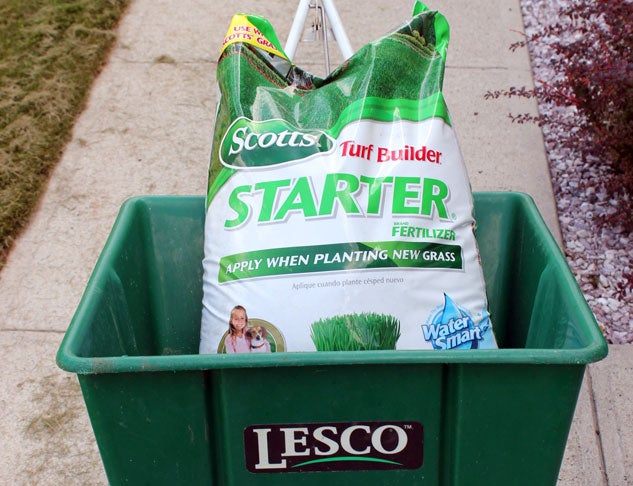
Apply a starter fertilizer. Formulations vary, but will typically be something like 18-24-12 or 24-25-4. The numbering system used states the amount of nitrogen, phosphorus and potassium (in that order). Nitrogen gives grass its verdancy, strength and thickness. Phosphorus encourages healthy root growth. And potassium aids in disease resistance and helps with less than ideal weather stresses. Phosphorus in starter fertilizers will be the higher number, and though your lawn probably has plenty of phosphorous, new seed needs this to help the germination process.
Press Seed into Soil
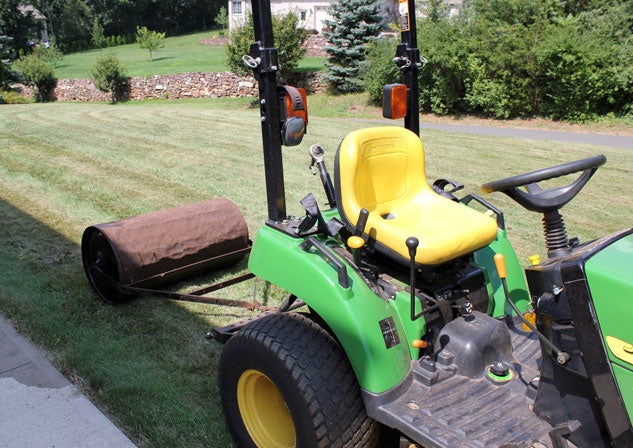
Roll your lawn and press the seed into the soil. Seed will not germinate unless it is pressed into the soil. Hand tools such as the back of a tine rake can work, though for larger areas are labor intensive. We’ve had good luck using a pull-behind roller but some will object to the compaction this may cause. An acceptable solution is to use a section of chain link fence to make a drag that will accomplish the mating of the seed and soil and break up the plugs at the same time. Weights such as cinder blocks can be added as needed.
Organic Material
Though the soil from the plugs or chaff left from dethatching is adequate, many prefer to apply a layer of organic material. If you choose to do so, it is better to make the layer thinner than thicker.
Water
Seed requires moisture to germinate. Watering lightly 2-3 times a day until the seed germinates yields good results. Remember to not soak the soil which can promote disease and root rot. At the same time, it is best that the new seed never dries out. As the seed germination progresses, the amount of water added can be cut back.
VIEW: How To Choose A Transmission For Your Tractor
Winterize
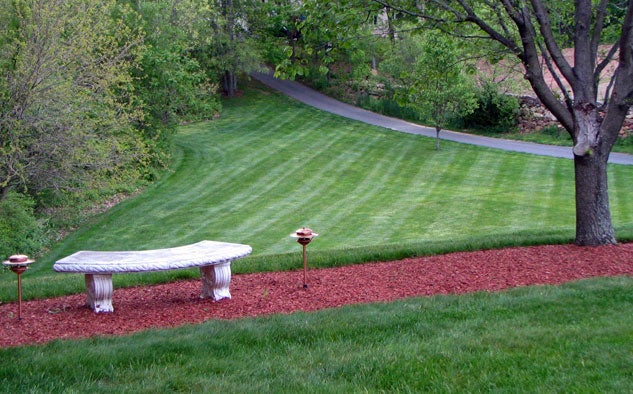
In mid to late November apply a winterizing fertilizer. This helps build stronger, deeper roots for the winter and is an important step to realizing a thicker, greener lawn next spring. Follow these steps and you will be on your way to that thick, lush lawn that is sure to be the talk of your neighborhood.
 Your Privacy Choices
Your Privacy Choices